Today’s new UseIt.com article, “World’s Best Headlines: BBC News” is an article after my own heart: a glowing review of BBC News. More specifically, it’s about the concisely written, yet richly explanatory headlines on the BBC News website.
I am so excited to see this wonderful review because for a few years, I was absolutely obsessed with getting a job at the BBC. To be honest, I guess I still am. I started listened to the BBC News World Report on NPR a few years ago when I didn’t have a cable (and had THE worst TV reception) and therefore no T.V. I was so impressed with the quality of their reporting and how much I learned about news from around the world as opposed to the very US-centric news reporting that I tend to get even from NPR or other US news sources. They easily could’ve focused on British news and just tossed in tidbits of world affairs, but it really was “fair and balanced” reporting from around the world.
I was also very impressed with the aggressiveness of the BBC reporters in their interviews who don’t let anyone get away with ambiguity – even when they speak to British, US or other Western officials. I loved how they would just call people out and tell them point blank how whatever rap they were supposed to give to reporters was just a load of bull. Wonderful.
I even tried to apply to the BBC after gradschool. Unfortunately, it never worked out, but even in the job rejections I was so impressed with the their class. They would send hand-signed rejection letters. Typically, the standard response is no response, or when I was lucky I would sometimes get a dry, automated email message telling me that there were no jobs for me but my resume would be kept on file for a year. So, yeah. I guess I am still a bit in love with the BBC. 🙂
So, I was so happy to see this article about their online news source. It’s really great to see props given to a deserving news site. I do have one qualm about the article: Nielsen says that using “4” instead of “four” in the headline would provide more space. That may be true for many other non-journalism websites, but here it would just be bad grammar. In this case, I think it’s better to stick with news writing convention – which is to write out numbers from 0-9, and use numerals for 10 and above – than with website convention. (I am writing a blog, so who cares!? ;P)
I also thought Nielsen’s explanation of BBC’s excellence as originating from their days as a radio broadcaster was also interesting.
“The news organization originated as a radio station, where word count is at a premium and you must communicate clearly to immediately grab listeners. In a spoken medium, each word is gone as soon as it’s uttered…”
That is very true for the performing arts as well. Dance and music are both art forms that exist only the present (videos and recordings aside) and the art is gone as soon as it has been danced or played. For instance, one of my dance teachers once said to me that it’s important to be fully committed to your technique even in class and not just on stage because you only get the one chance to do that pirouette or that arabesque as best you can. You can try it again, but it’s won’t be the same step. I guess it’s the same as saying you never step in the same river twice. That type of attitude, that is doing your best even for mundane things, is a bit of a perfectionist attitude, but over time it can lead to excellence.
Ha! Yet again I’ve managed to connect dance and technology! Yay for me! 🙂
